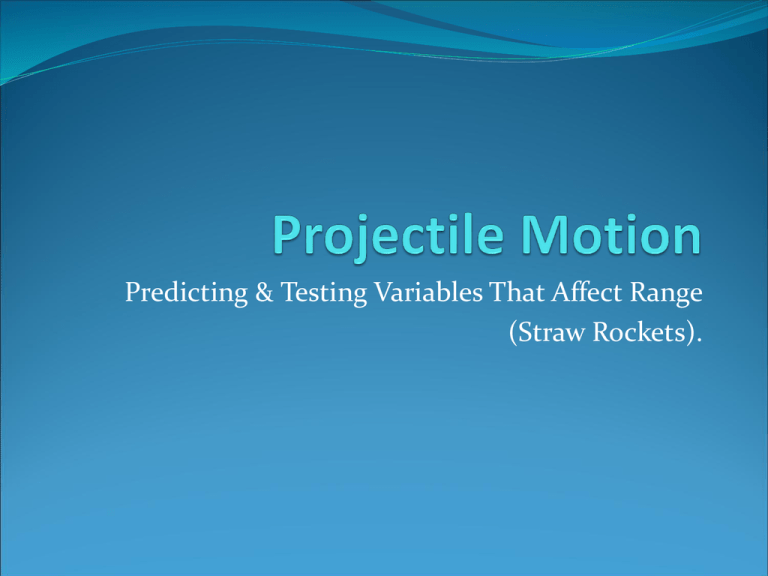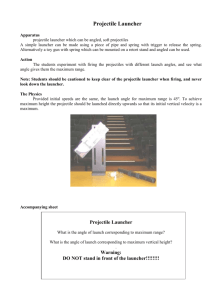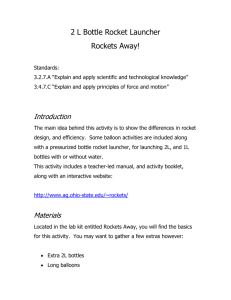Projectile Motion
advertisement

Predicting & Testing Variables That Affect Range (Straw Rockets). Lab Description Students are asked to define “range” in their own words Students are presented the materials and show how the rockets are launched Students are asked to make a list of variables that might affect the “range” of the straw rocket Students are then asked to devise a method for testing the variables and record all results Students are asked to write a one-page summary of their procedure and conclusions Lab Description – cont. List of supplies; Straws Clay Note cards Hot glue guns & scissors Triple beam balances & meter sticks Launch apparatus Goals – general goals Students will test their understanding of “range” as related to projectile motion Students will use the Scientific Process to develop an experiment with procedure and test variables Students will develop a correct understanding of “range” for projectile motion How would I use this in class Introductory guided inquiry-based lab Used to introduce projectile motion Used as a student developed experiment Standards & Frameworks Physical Science: Strand: Physics P.6.PS.1 – Analyze how force affects motion (one-dimension (linear) and two-dimension (projectile and rotational)) P.6.PS.7 – Design and conduct investigations demonstrating Newton’s first law of motion P.6.PS.8 – Design and conduct investigations demonstrating Newton’s second law of motion P.6.PS.9 – Design and conduct investigations demonstrating Newton’s third law of motion Strand: Nature of Science NS.10.PS.1 - Develop and explain the appropriate procedure, controls, and variables (dependent and independent) in scientific experimentation NS.10.PS.2 - Research and apply appropriate safety precautions (refer to ADE Guidelines) when designing and/or conducting scientific investigations NS.10.PS.3 – Identify sources of bias that could affect experimental outcome NS.10.PS.4 - Gather and analyze data using appropriate summary statistics NS.10.PS.5 - Formulate valid conclusions without bias NS.10.PS.6 – Communicate experimental results using appropriate reports, figures, and tables See http://arkansased.org/educators/curriculum/frameworks.html#science for more details. Adaptations and Q(s) Hit the target competition – students will use their knowledge gained in this activity to compete to hit a target for bonus points on an exam. Time limit for building rocket ad limit on number of launches. Mathematical model of projectile motion – (PLC activity with math teacher) – students will use data collected in the physics class to graph and develop a mathematical model of projectile motion. Spring Presentation Slides The following slides are the results of performing the experiment with my students in the classroom. This is my Spring 2011 MSP follow-up presentation. Range Students were asked to write a definition of “range” for their straw rockets. Sample Definitions: “Range is the distance the rocket will travel.” “Range is how far my rocket will fly.” “The distance in the air my rockets moves is called range.” Variable Predictions Students were asked to make predictions about the variables that would affect the “range” of their straw rockets. Sample list of variables chosen by the students: Length of the straw Amount of clay in the nosecone How high I lift the launcher The angle of the launcher The design of the fins Wind Testing Your Predictions Students were asked to test their predictions and organize the results in a table. Sample table for angle of launcher Angle (Degrees) Distance (m) 30 8.95 35 9.32 40 9.76 45 10.05 50 9.82 60 9.12 Sample table for length of straw with 15 grams of clay for nosecone Length of Straw (m) Distance (m) .30 8.54 .27 8.46 .24 8.21 .21 8.05 .18 7.62 Conclusion Statements Students were asked to make conclusion statements about the variables they choose to test. “The length of the straw matters. The shorter the straw the more wobbly the path. So the shorter the distance.” “The angle makes a big difference. The longest distance was around 45 degrees.” Student reactions to the lab “Making the rockets was so much fun!” “I liked when one stuck to the ceiling.” “It was cool!” “I liked changing the angle and trying different heights for the launcher.” Teaching Moments One group of students tried gluing on 6 or 7 pairs of fins and found the weight made a bigger difference than the number and size of the fins. One group was trying to test if the air made a difference. I suggested taping different size note cards to the nosecone. Future Changes Allow two days for students to test all of the variables they chose. Combine all the data into one chart. Have the students look for trends in the data.







